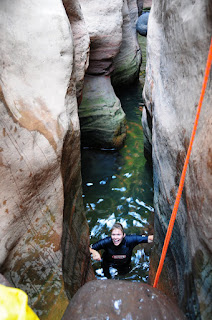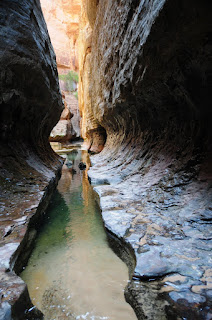Having grown up in New harmony you would think I would know all the good places to hike in the neighborhood. Unfortunately, I didn't hike much when I was growing up. We did a lot of walking while hunting, but mostly we rode horses as far as we could, then hiked. I don't ever remember looking for a place specifically to go hiking.
When I returned to the area a few years ago I heard people talk about Kanarra Falls. I thought it couldn't be much or I would know about it. Finally I decided to find out by asking around and talking to people who had been there. Based on their descriptions I decided it was definitely somewhere I should go and started making plans.
 On July 11, 2009 Jillyn and Kenny were here and wanting to do a hike. We talked about going back up to the Beaver area and trying for Delano Peak again (last time we climbed Mount Holly by mistake instead of Delano) but decided it was too far for the time we had available. I suggested Kanarra Falls and they agreed.
On July 11, 2009 Jillyn and Kenny were here and wanting to do a hike. We talked about going back up to the Beaver area and trying for Delano Peak again (last time we climbed Mount Holly by mistake instead of Delano) but decided it was too far for the time we had available. I suggested Kanarra Falls and they agreed.The trail starts on the east side of Kanarraville up toward the water tank. There is a parking area below the tank, then the trail goes up the road past the tank, which is the hardest part of the entire hike.
 First thing up the trail we met this wild-eyed guy who was muttering somewhat incoherently that he had almost stepped on a rattlesnake. Lucky for the snake because he weighed about 300 pounds. He pointed a shaky finger to a bush and we found the snake there scared half to death.
First thing up the trail we met this wild-eyed guy who was muttering somewhat incoherently that he had almost stepped on a rattlesnake. Lucky for the snake because he weighed about 300 pounds. He pointed a shaky finger to a bush and we found the snake there scared half to death. The Kanarra Falls hike, in my opinion, is one of the best kept secrets in the area. It is a beautiful slot canyon within walking distance for even the most inept. Small children can do it as it is only a couple of miles on pretty flat terrain. It might even be nice to have some younger folks along to protect you from the snakes. Some of the hike involves getting wet, and the creek probably flows higher and colder in the spring of the year, but in mid summer the water level is low and hot temperatures make a little soaking quite pleasant.
The Kanarra Falls hike, in my opinion, is one of the best kept secrets in the area. It is a beautiful slot canyon within walking distance for even the most inept. Small children can do it as it is only a couple of miles on pretty flat terrain. It might even be nice to have some younger folks along to protect you from the snakes. Some of the hike involves getting wet, and the creek probably flows higher and colder in the spring of the year, but in mid summer the water level is low and hot temperatures make a little soaking quite pleasant. At the first falls there is a log ladder that isn't too difficult to climb. It even has a rope handrail. If you don't want to climb this you can turn around here and still have had a great hike. If you are the adventurous type and have to see what is at the top of the falls, continue on.
At the first falls there is a log ladder that isn't too difficult to climb. It even has a rope handrail. If you don't want to climb this you can turn around here and still have had a great hike. If you are the adventurous type and have to see what is at the top of the falls, continue on. Above are more slot canyons and more wading. It is kind of hard to avoid getting wet, at least to your knees.
Above are more slot canyons and more wading. It is kind of hard to avoid getting wet, at least to your knees.
 About midway between the lower and upper falls you encounter this water park. There is no entrance fee, but there may be some waiting in line as there is only one slide. Kids were sliding down the slick rocks into the pool below while parents cooled off. I think we may have interrupted a wet tee shirt contest.
About midway between the lower and upper falls you encounter this water park. There is no entrance fee, but there may be some waiting in line as there is only one slide. Kids were sliding down the slick rocks into the pool below while parents cooled off. I think we may have interrupted a wet tee shirt contest. I have hiked Buckskin Gulch, which is considered one of the premier slot canyons in the world, but some of the places in Kanarra Creek are just as impressive and are much more accessible.
I have hiked Buckskin Gulch, which is considered one of the premier slot canyons in the world, but some of the places in Kanarra Creek are just as impressive and are much more accessible. After some more slot canyon you arrive at the second falls. this one is a little more difficult, mainly because there is no log ladder. The only help is a rickety board ladder of sorts that has been nailed together. I put my camera into a plastic bag and then in my pack and tried to make the ascent. About half way up you have to grab a wet rope and pull yourself the rest of the way.
After some more slot canyon you arrive at the second falls. this one is a little more difficult, mainly because there is no log ladder. The only help is a rickety board ladder of sorts that has been nailed together. I put my camera into a plastic bag and then in my pack and tried to make the ascent. About half way up you have to grab a wet rope and pull yourself the rest of the way. 


 I still wasn't too concerned for our own safety, as the fire was a long way from town. As we watched, I commented that I would start to be concerned when it came over Lawson Hill. In less than an hour it was coming over the hill, and as the evening breeze started to blow off the mountain the fire began racing north into the west side of town, threatening several homes and structures.
I still wasn't too concerned for our own safety, as the fire was a long way from town. As we watched, I commented that I would start to be concerned when it came over Lawson Hill. In less than an hour it was coming over the hill, and as the evening breeze started to blow off the mountain the fire began racing north into the west side of town, threatening several homes and structures. It was quite a helpless feeling as we watched the fire come closer and closer. We rigged up all our hoses and put sprinklers around the house and on the roof. We loaded a few emergency things and photo albums into the car just in case, still not thinking it would really get to us.
It was quite a helpless feeling as we watched the fire come closer and closer. We rigged up all our hoses and put sprinklers around the house and on the roof. We loaded a few emergency things and photo albums into the car just in case, still not thinking it would really get to us.
 The fire burned through Gordon Pace's stockyard and haystack on its way north, which is about a quarter mile from our home. It seemed a lot closer when all you could see was a wall of smoke and fire.
The fire burned through Gordon Pace's stockyard and haystack on its way north, which is about a quarter mile from our home. It seemed a lot closer when all you could see was a wall of smoke and fire.



 Around 2:00 am we were awakened by sirens and I went out to the corner and looked toward our home to see the fire had moved down the mountain and was literally at the back of Little Mountain which was glowing like a football stadium under full lights.
Around 2:00 am we were awakened by sirens and I went out to the corner and looked toward our home to see the fire had moved down the mountain and was literally at the back of Little Mountain which was glowing like a football stadium under full lights. I quickly dressed and hurried to our home and upon arrival there realized the fire was way too close for comfort. I called Elma Lynne and told her that if she wanted anything else out of the house she better come and get it. There was a search and rescue man knocking on our door to tell us to get out, so I relayed the message to Scott who was sleeping peacefully. Then I headed for Little Mountain to get a good view of what was happening. On the way there I ran into a Forrest Service truck and the driver said he was lost. I told him how to get back to town, and asked him to get me a fire truck if he possibly could. Within twenty minutes we had two fire trucks and about thirty Hot shots on site.
I quickly dressed and hurried to our home and upon arrival there realized the fire was way too close for comfort. I called Elma Lynne and told her that if she wanted anything else out of the house she better come and get it. There was a search and rescue man knocking on our door to tell us to get out, so I relayed the message to Scott who was sleeping peacefully. Then I headed for Little Mountain to get a good view of what was happening. On the way there I ran into a Forrest Service truck and the driver said he was lost. I told him how to get back to town, and asked him to get me a fire truck if he possibly could. Within twenty minutes we had two fire trucks and about thirty Hot shots on site. As we watched from Little Mountain the wind calmed down and the fire stopped its advance around 4:00am. At this point they decided to do a back-burn from the fire line along the forest boundary, and soon the night sky was again vivid with fire, but this time it was burning away from us. As daylight came the fire near us was pretty well controlled and we had a pretty good fire break just in case it decided to turn back.
As we watched from Little Mountain the wind calmed down and the fire stopped its advance around 4:00am. At this point they decided to do a back-burn from the fire line along the forest boundary, and soon the night sky was again vivid with fire, but this time it was burning away from us. As daylight came the fire near us was pretty well controlled and we had a pretty good fire break just in case it decided to turn back.

























